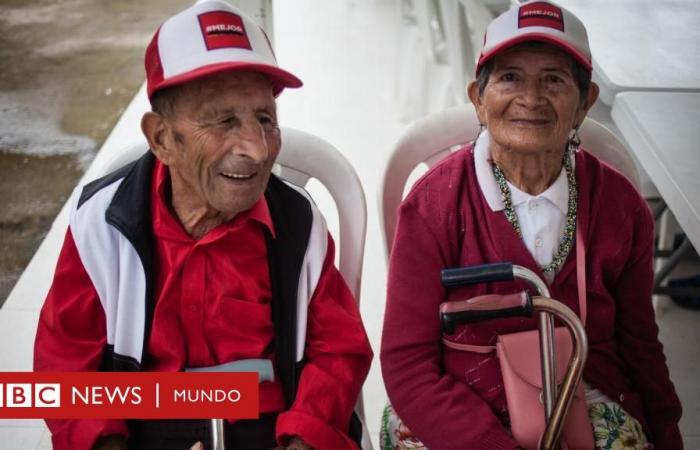
Image source, Getty Images
Weeks before completing half of his term, the president of Colombia, Gustavo Petro, obtained one of his greatest triumphs since he became president in August 2022.
His bill to reform pensions, one of the major programs of his ambitious campaign, was approved by the Colombian Congress on June 14.
“This is the main social achievement of the working people of Colombia in a long time. It is the first major reform approved by the government of change“, celebrated Petro on the social network X.
The approval of the project represents a respite for the Colombian president, who will reach the middle of his term with doubts about his leadership (he announced that he will make changes in his cabinet for the third time since he has been president), important legislative defeats such as the collapse of his health reform in the Senate and with the challenge of achieving “total peace” that promises for Colombia, still far from materializing.
Broadly speaking, the pension reform expands coverage and modifies the distribution of resources by transferring a large part to a public fund and taking weight away from private funds.
“The current system had to be changed. It was regressive and unfair,” he tells BBC Mundo. Sergio Urzúa, professor of economics at the University of Maryland in the United States.
The new system, which will operate based on four contribution pillars, will also protect older adults in poverty, with the government estimating that around 2.6 million Colombian older adults will benefit through a solidarity income.
Although many value the project as an improvement to the current system, experts consulted by BBC Mundo question its long-term financial sustainability and call for other complementary structural changes.
So, what does the reform consist of and how does it resemble that of other countries in the region?
An advance for the most vulnerable
Let’s travel to a rural Colombian area.
Let’s imagine that we meet a rural worker. This man is a few months away from turning 62, the retirement age for men in Colombia, but he will not receive a pension because he never contributed.
He worked since he was 18, but as happens to many rural workers, informality, income instability and other factors prevented him from saving for old age.
Your situation is vulnerable. He has health problems and it will be difficult for him to continue working for a long time. The risk of falling into extreme poverty is high.
Image source, Getty Images
Fortunately for you, this situation is about to change. When you turn 65, you will receive a monthly amount of 232,000 pesos (US$57).
Many rural workers are among the millions of older adults in vulnerable situations who will benefit from the pension reform promoted by the Petro government.
Specific, These will benefit from the solidarity pillar of the reform which, together with another pillar called semi-contributory, seeks to expand retirement coverage and protect those who never contributed or do not meet the requirements to access the pension.
Which, according to experts, represents progress and an improvement in the quality of life of the most vulnerable in the country.
A 4 pillar system
The new system, which would become effective as of July 1, 2025, is based on four pillars: contributory, semi-contributory, voluntary savings and solidarity.
These would apply according to the individual socioeconomic level:
- Contributory: for dependent and independent workers, public servants and people with the ability to pay to contribute and access a pension.
- Semi-contributory: for people affiliated with the system who, at 65 years of age, have not met the requirements to access a pension.
- Voluntary savings: for people who make voluntary savings in addition to the mandatory one.
- Solidary: for people in conditions of extreme poverty and vulnerability.
The idea is to strengthen the role of the state administrator Colpensiones, reduce subsidies for high pensioners and expand the coverage of the current system.
“Right now, a public and a private distribution system coexist that compete with each other,” Mauricio Olivera, administrative and financial vice-rector of the Universidad de los Andes, explains to BBC Mundo.
This model is commonly called the parallel system, in force in Colombia since 1993 and where people can contribute to the pay-as-you-go system, the public system, or to the individual contribution system managed by private funds.
“The problem is that in our pay-as-you-go system, the savings are not enough to pay pensions and a subsidy is given, but this is higher the higher the contribution. That is, the more job opportunities the person has,” continues Olivera, who was also president of Colpensiones and vice minister of employment and pensions in the Colombian government.
Olivera, like a notable number of experts, agree that This system “is regressive” and needed a change.
Image source, Getty Images
“A public policy should focus on the most vulnerable and not the least vulnerable. Moving to this pillar system would reduce this regressivity,” says Olivera.
The new project obliges all Colombians who earn up to 2.3 minimum monthly salaries, about 2.9 million pesos (US$743), to make their pension contributions to the state-owned Colpensiones.
Anyone who earns more than that figure can select a private fund for individual savings of the surplus.
The resources will be administered by the Central Bank of the Republic.
The reform kept the pension age at 62 years for men with 1,300 weeks of contributions and at 57 years for womenalthough the required weeks were reduced to 1,000 for them.
Additionally, women will be able to gradually reduce the time required for retirement for each child by 50 weeks, with a maximum of three, bringing the requirement to 850 weeks.
The reform establishes that men with 900 weeks of contributions and women with 750 will continue to apply the current standard. That is, they will not be obliged to contribute a part of their income to the state fund if they are in a private fund.
Is the new system sustainable?
Experts and critics have cast doubts on the sustainability of the new system and the damage it would have for the capital market and public finances.
“I have the impression that it will work like a balm, a patch, in the first few years. But This system will force continuous changes to make it better“, Urzúa, the economist at the University of Maryland, tells BBC Mundo.
Colombia, like many countries in the world, faces a worrying drop in birth rates and population aging.
This, in terms of pensions, implies that “there will be fewer people working and paying the pensions of an aging population group that will continue to grow,” says Urzúa.
Image source, Getty Images
“Sooner or later the numbers will not work if more changes do not occur. Algebra does not lie and we will have to look for other mechanisms to finance solidarity,” he adds.
Olivera, based on calculations from the Ministry of Finance, says that Colombia would have a margin of about 40 years to think about other complementary changes, “such as a well-done labor reform.”
“There are several key parameters that will not be touched on in this reform. Some are very difficult at a political level, but at some point they will have to be done,” analyzes Olivera.
“We contribute around 16% when in most countries it is above 25%. Women retire at 57 and men at 62, one of the lowest retirement ages in the region,” he adds.
For Urzúa, these are important issues that, in his opinion, were not discussed enough with this Petro reform and that in the long term may reveal the deficiencies of the new system.
What happens in the rest of Latin America?
In general, in the region there are two large systems: public (with state financing) and private (with individual financing).
There is a growing trend of mixed systems (which finance retirements with State funds and individual contributions) with contributory and solidarity pillars.
There are also parallel systems, in which people retire with public funds or personal funds, and integrated models, which add minimum pensions to the individual savings system.
Since the 1980s, a dozen countries in the region incorporated elements of “privatization” into their pension systems.
But in recent years things began to change and, as in Colombia, solidarity mechanisms were debated and introduced to support those over 65 years of age and other vulnerable populations, even in those countries with private or integrated systems.
In Colombia, in this case, we would move from a parallel system, like the one that also prevails in Peru, to a mixed one.
The Economic Commission for Latin America and the Caribbean (ECLAC) says that moving to a mixed system is increasingly common in the region, in addition to the “growing role of the State” in pension reforms or “re-reforms.”
Image source, Getty Images
Uruguay, Costa Rica or Mexico, with their particularities, are examples of countries with mixed systems.
“Even in Chile, where a private system prevailed, a pillar of solidarity was also established that has grown over time,” says Urzúa.
Argentina would be the clearest example where a single public distribution system prevails and the Dominican Republic the only regional example “with a pure substitutive model,” according to ECLAC.
At the level of challenges, Colombia faces the same ones as Latin America and the rest of the world: ensure the sustainability of the system in a general panorama of low birth rate and rapid aging.
Beyond the model, Olivera considers “that the pension system is very deficient in much of Latin America.”
“The current reform does not resolve that Colombia spends very little on pensions, only 4.5% of GDP. In Uruguay, a country seen as a model for its low inequality, around 9% is spent,” says the expert.
“Colombian society will have difficult conversations about how to increase spending while ensuring its sustainability,” he adds.
Quite a challenge on a planet where the growth of debt and inequality levels, in addition to other problems, threaten welfare systems.
And remember that you can receive notifications in our app. Download the latest version and activate them.





